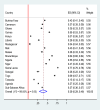Malaria-anemia comorbidity and its determinants among pregnant women in high- and moderate-malaria-risk countries in Sub-Saharan Africa
- PMID: 40804746
- PMCID: PMC12344846
- DOI: 10.1186/s40249-025-01357-x
Malaria-anemia comorbidity and its determinants among pregnant women in high- and moderate-malaria-risk countries in Sub-Saharan Africa
Abstract
Background: Malaria and anemia remain a major public health problem in Sub-Saharan Africa, with pregnant women being particularly vulnerable to its adverse effects. Despite significant efforts to control malaria and anemia, the burden and adverse effects persist, especially in developing countries among pregnant women. Existing studies investigated malaria and anemia separately and identified individual-level factors as contributors to malaria or anemia, yet the influence of community-level factors remains underexplored. This study aimed to assess the malaria-anemia comorbidity and its determinants among pregnant women in high- and moderate-malaria-risk countries in Sub-Saharan Africa.
Methods: Data from the Malaria Indicator Surveys (MIS) conducted between 2016 and 2022 across 17 Sub-Saharan African countries were used for analysis. The study included a total of 50,545 weighted samples. Multilevel logistic regression was used to assess individual and community-level factors associated with malaria-anemia comorbidity. Factors associated with malaria-anemia comorbidity were considered significant at P-values < 0.05. A model with the lowest deviance and highest log-likelihood ratio was selected as the best-fit model.
Results: The pooled prevalence of malaria-anemia comorbidity among pregnant women was 39.00% (95% CI 29.00-49.00). No formal education (OR = 1.43, 95% CI 1.34-1.54), using untreated bed nets (OR = 1.23, 95% CI 1.16-1.30), poor wealth index (OR = 2.37, 95% CI 2.18-2.57), not using indoor residual spraying (OR = 2.15, 95% CI 1.87-2.48), households without a television (OR = 1.33, 95% CI 1.23-1.44), rural residence (OR = 2.73, 95% CI 2.54-2.93), and residing in West Sub-Saharan Africa (OR = 8.00, 95% CI 7.47-8.57), Central Sub-Saharan Africa (OR = 6.76, 95% CI 76.03-7.57), and South Sub-Saharan Africa (OR = 18.76, 95% CI 17.3-20.4) were determinants of malaria-anemia comorbidity.
Conclusions: This study revealed high malaria-anemia comorbidity among pregnant women in high- and moderate-malaria-risk countries in sub-Saharan Africa, with both individual- and community-level factors as significant determinants. Health policies should prioritize targeted interventions for pregnant women, especially in rural areas, with an emphasis on increasing untreated bed net use, and region-specific strategies, particularly in West, Central, and South Sub-Saharan Africa, where malaria-anemia comorbidity burden is notably high.
Keywords: Anemia; Comorbidity; Malaria; Pregnant women; Sub-Saharan Africa.
© 2025. The Author(s).
Conflict of interest statement
Declarations. Ethics approval and consent to participate: This study is based on a secondary analysis of publicly available, de-identified data from the Malaria Indicator Surveys (MIS). Ethical approval for this specific analysis was not required. Permission to access and use the dataset was obtained through registration and approval from the DHS Program’s data repository. All data were fully anonymized by the original data collectors prior to public release, in accordance with ethical guidelines. Further information and access procedures can be found at: https://www.dhsprogram.com/data/dataset_admin/index.cfm . Consent to publication: Not applicable. Competing interests: The authors declare that they have no known competing financial interests or personal relationships that could have appeared to influence the work reported in this paper.
Figures



Similar articles
-
Spatial variation and multilevel determinants of malaria infection among pregnant women in Sub-Saharan Africa: using malaria indicator surveys.BMC Infect Dis. 2025 May 4;25(1):654. doi: 10.1186/s12879-025-11037-8. BMC Infect Dis. 2025. PMID: 40320558 Free PMC article.
-
Individual and community level determinants of unmeet pregnancy complication education among pregnant ANC visitor women in Sub-Saharan Africa: a multilevel analysis of the recent demographic and health survey.BMC Pregnancy Childbirth. 2025 Jul 9;25(1):733. doi: 10.1186/s12884-025-07843-2. BMC Pregnancy Childbirth. 2025. PMID: 40634865 Free PMC article.
-
Indoor residual spraying for preventing malaria in communities using insecticide-treated nets.Cochrane Database Syst Rev. 2022 Jan 17;1(1):CD012688. doi: 10.1002/14651858.CD012688.pub3. Cochrane Database Syst Rev. 2022. PMID: 35038163 Free PMC article.
-
Prescription of Controlled Substances: Benefits and Risks.2025 Jul 6. In: StatPearls [Internet]. Treasure Island (FL): StatPearls Publishing; 2025 Jan–. 2025 Jul 6. In: StatPearls [Internet]. Treasure Island (FL): StatPearls Publishing; 2025 Jan–. PMID: 30726003 Free Books & Documents.
-
Strategies of testing for syphilis during pregnancy.Cochrane Database Syst Rev. 2014 Oct 29;2014(10):CD010385. doi: 10.1002/14651858.CD010385.pub2. Cochrane Database Syst Rev. 2014. PMID: 25352226 Free PMC article.
References
-
- Titiloye MA, Onuosa EA, Arulogun OS. Malaria prevention practices among pregnant women resident in two Nigeria army barracks, Ibadan, south western, Nigeria. J Public Health Epidemiol. 2017;9(4):92–8.
-
- Kolawole EO, et al. Malaria endemicity in sub-Saharan Africa: past and present issues in public health. Microbes Infect Dis. 2023;4(1):242–51.
-
- Tseha ST. Plasmodium species and drug resistance, in Plasmodium species and drug resistance. IntechOpen; 2021.
LinkOut - more resources
Full Text Sources

